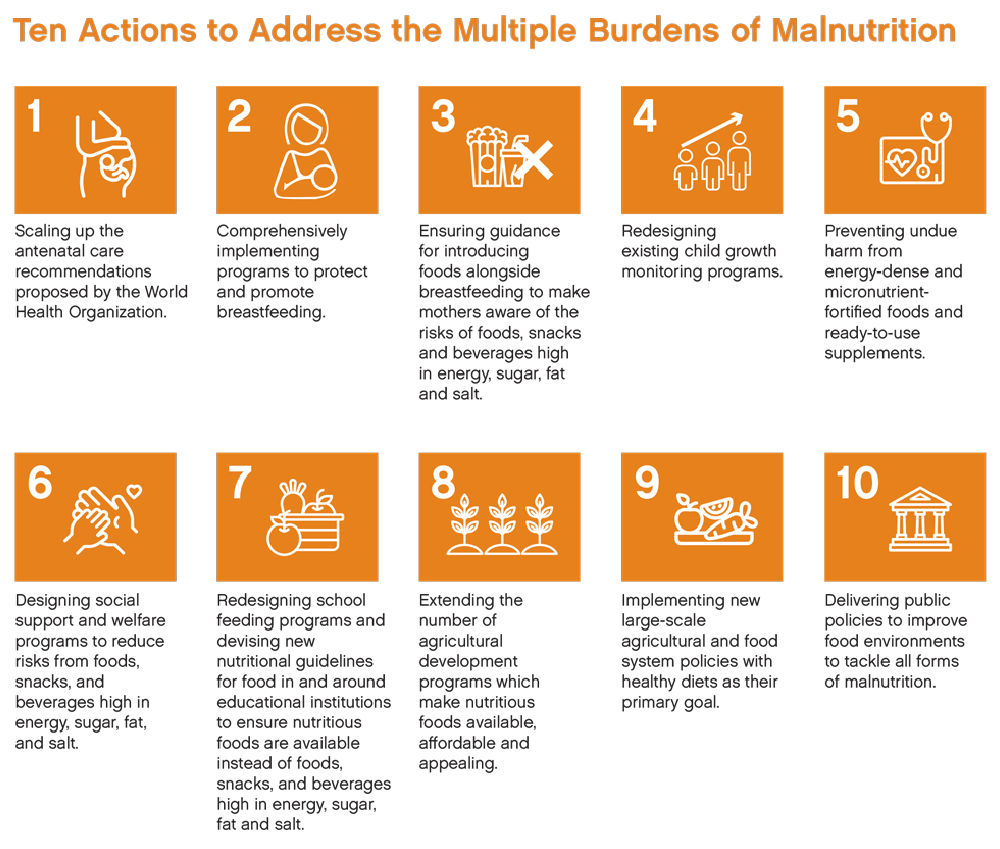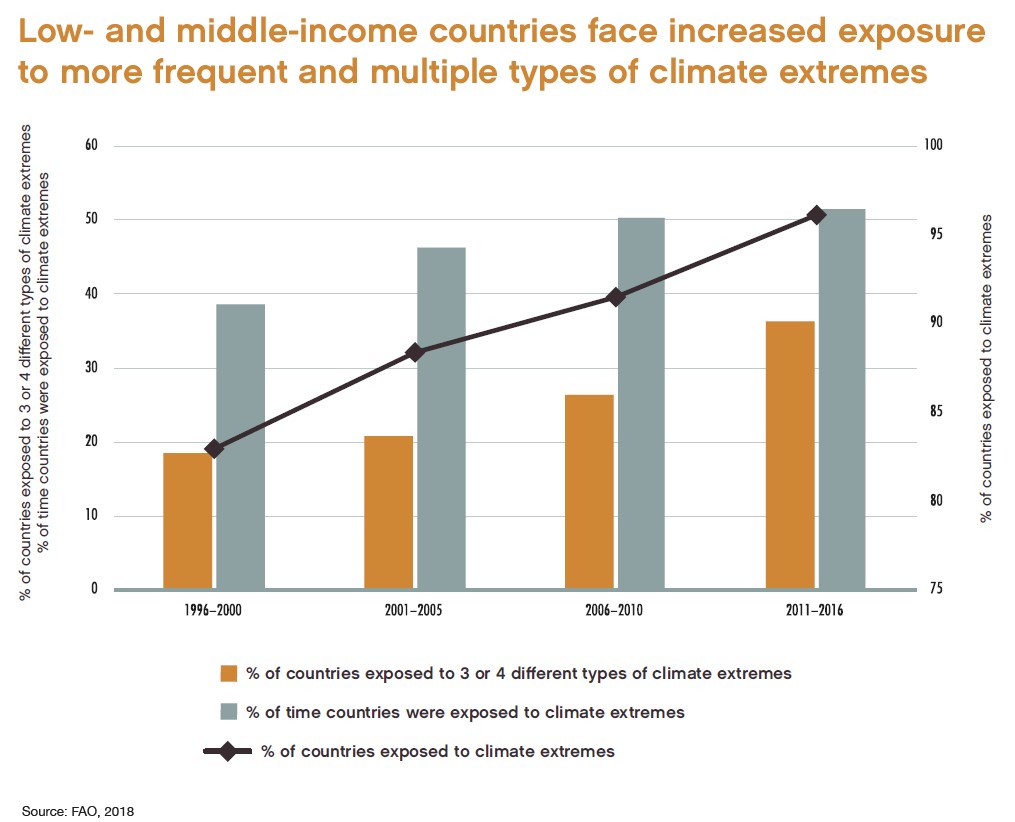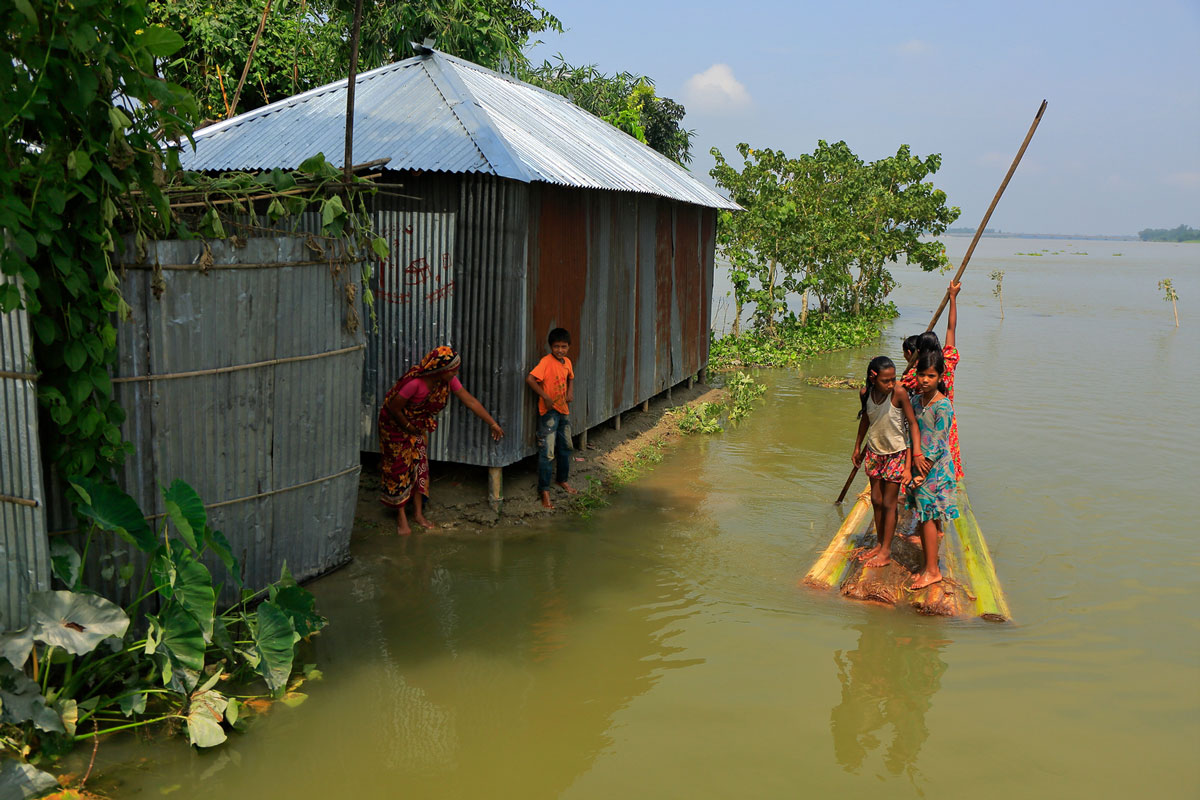
As we began preparing the 2020 Hunger Report for its release, the world as we know it changed dramatically in a matter of weeks. At the time of this writing, the COVID-19 pandemic is unfolding, and people everywhere are on edge.
No country will be spared from this global health crisis, and people from all walks of life will see their lives upended as a result of the virus and its economic fallout. The pandemic will hit low-income countries and families hardest.
People experiencing malnutrition and poverty are especially vulnerable to chronic health conditions and infectious diseases. In the 2020 Hunger Report, we focus on the importance of good nutrition and the systems needed to deliver it sustainably and equitably. This topic was crucial before the COVID-19 crisis, and the pandemic underscores the main messages of the report:
People at greatest risk during the coronavirus pandemic are already grappling with poorer health caused by hunger and malnutrition . Globally, the leading causes of death are diet-related. Too much, not enough, and not enough of the right kinds of food all lead to poor health, making people more susceptible to disease. From food safety and food security to dietary quality, food systems are essential to protecting health. Ensuring adequate nutrition as part of the response to the pandemic will be critical to building resilience.
Global challenges require global solutions . The worst thing in a crisis is for nations to isolate themselves. Many countries have acted quickly to close borders. This could have devastating consequences for food security and nutrition. The global food system is nothing more than an amalgam of national and local systems that touches everyone. If countries cut one another off, the pandemic could cause major disruptions in food supply chains. It is critical to ensure the flow of trade in food.
Climate Change is a Hunger Issue
Thur, Sept 24
11 a.m. - noon ET
Watch "Climate Change is a Hunger Issue"
Recorded September 24, 2020
The world saw the consequences of disrupted trade as recently as 2006-2008, when global food prices soared due to a confluence of factors. Political leaders in several major food-producing nations set a moratorium on exports. The export bans predictably led to a spike in international food prices, threatening a surge in world hunger. Through institutions such as the G-7 and G-20, countries with the strongest economies came together to offer support to smallholder farmers. The U.S. government played a leading role in providing emergency food assistance and established Feed the Future, the global food security and hunger program that supports agriculture to this day.
A coordinated global response to COVID-19 will be important, as it was in the aftermath of the food price crisis. The response should include critical health guidance from the World Health Organization and economic support to the poorest countries through the World Bank, International Monetary Fund, and other international financial institutions. The World Food Program should support governments in dozens of countries with school meal programs and emergency assistance in especially hard-hit communities. Many other multilateral institutions must step up and provide coordinated assistance.
Better coordination on global food security and agriculture will make it possible for food systems to bounce back more quickly once the coronavirus is contained. Food systems are resilient. With a comprehensive response that includes a focus on ensuring that food systems continue to function and are delivering good nutrition, the world could “bounce back better.”
Finally, the current disease outbreak has made clear to everyone the grim consequences of huge economic, social, and racial inequities. Equity is an issue we focus on in this report because it has a significant impact on the food system. As the world emerges from the pandemic, recovers and rebuilds, everyone must pay maximum attention to leaving no one behind .

Rev. David Beckmann
President Emeritus, Bread for the World and Bread for the World Institute
Bread for the World Institute’s 2020 Hunger Report, Better Nutrition, Better Tomorrow , examines the challenge of ending global hunger and all forms of malnutrition and offers recommendations to accelerate progress.
Currently, there are 822 million people undernourished because of hunger, more than 2 billion people undernourished because of vitamin and mineral (micronutrient) deficiencies, and another 2 billion overweight or obese. 1

Pearl Gaone Ranna intends to transform the agricultural sector for all women.

Trey Hill , a third-generation family farmer in Maryland, is changing the way we grow our food.

Heber Brown takes on access to nutritious foods in Baltimore's black communities
The Sustainable Development Goals (SDGs), a set of 17 interconnected goals adopted by the United States and 193 other countries in 2015, include a goal to end hunger and all forms of malnutrition by 2030. The World Health Assembly (WHA) in 2012 adopted a set of global maternal/child nutrition targets for 2025. The SDGs and the WHA targets are touchstones for all our recommendations in the report.
The world is not on track to end hunger and malnutrition by 2030. Neither is it on track to reach the maternal/child nutrition targets. To get on a path to success, food systems need to make healthy diets available and affordable to all; ensure that food is produced sustainably; and support equitable livelihoods for all workers in food systems.
Food systems encompass farmers, ranchers, fishers, processors, transporters, marketing agents, retail operations, restaurants, and consumers in a complex, dynamic web. Governments and the international community led by businesses and civil society working in unison must strengthen the web of global, national, and local food systems.
Better Nutrition, Better Tomorrow is most concerned with the SDG principle of “reaching the furthest behind first,” and that means everywhere. Inequities associated with gender, race, ethnicity, and other identifiers of marginalized social status present the greatest obstacles to ending hunger and malnutrition and are endemic in all societies.
Reaching the people and communities furthest behind and ensuring equity in nutrition require tackling structures and attitudes, some deeply entrenched within a society, which allow inequities to choke progress against hunger and malnutrition.
1 Many countries today face multiple burdens of malnutrition. As a result, the world overall is not on track to achieve the nutrition goals established by the global community.
2 Food systems present a model for addressing the challenges we face. Food systems should place less emphasis on quantity of calories produced, and more on improving dietary quality.
3 Failing to come to terms with climate change is the biggest threat to sustainable progress against malnutrition. Food systems are both “victims” and “instigators” of climate change and must adapt.
For most of human history , hunger was by far the most pressing nutrition challenge. As recently as the 1960s, one in three people worldwide was chronically undernourished—hungry because they did not get enough calories. Today, the global hunger rate is about one in 10 people. 2
Thomas Malthus, the 18th-century English economist, famously theorized that population growth would eventually outstrip human ability to produce enough food. The Malthusian theory has been debated and proven unwarranted time and again. Malthus didn’t know about climate change, but his heirs would now maintain that climate change will inevitably lead to mass hunger. 3 Since 2015, the global hunger rate has been on the rise, and it is clear that climate change is a factor. 4
Micronutrient deficiencies are a different kind of nutrition challenge, receiving much more attention now. Although micronutrient deficiencies are common in people of all ages, the evidence is definitive that the most important window for human nutrition is the earliest—from a woman’s pregnancy to her child’s second birthday. This period, often called the 1,000 Days, is the time to ensure that children get the nutrients they need.

The opposite is also true. The 1,000 Days is the time when lack of adequate nutrients is most likely to cause death or lifelong disability. Currently, one in five of the world’s children under 5 is stunted from chronic malnutrition. 5 Stunting scars people for life, impairing children’s physical and cognitive development and making them more susceptible to disease.
Malnutrition has been and is still the world’s leading cause of poor health. 6 It is highly unlikely that the situation will change unless the world accomplishes two things. The first is meeting the WHA nutrition targets—which include, for example, reducing childhood stunting by 40 percent by 2025—and achieving SDG 2, which calls for ending hunger and forms of malnutrition such as stunting by 2030. The second is responding to comparatively new but rapidly rising forms of malnutrition: overweight and obesity. A growing number of low- and middle-income countries face what has been called a “triple burden” of malnutrition: undernourishment, micronutrient deficiencies, and obesity. At this point, two-thirds of the world’s overweight and obese people live in low- and middle-income countries. 7 The national health systems of most countries are poorly prepared to treat obesity or its consequences, which include chronic diseases such as diabetes, hypertension, and heart disease.
Since 2015, the global hunger rate has been on the rise, and it is clear that climate change is a factor.
Access to adequate amounts of nutritious food cannot be taken for granted even in a wealthy country such as the United States. As of 2018, according to federal statistics, 11.1 percent of the U.S. population was food insecure. 8 “Food insecure” is an awkward term that emphasizes what people do not have: a living situation where all members of the family are able to eat an adequate diet throughout the entire year. 9 At times, one or more family members may have to skip meals or go without eating for an entire day. Families buy less expensive, less nutritious foods so that they can at least avoid hunger pangs. Not surprisingly, people who are food insecure have higher rates of overweight and obesity than the rest of the U.S. population.
Nutrition challenges are more complex than ever. When the only problem in sight was hunger, governments subsidized the production of staple grains, which was the simplest and cheapest way to boost food supplies. This strategy doesn’t work for micronutrient deficiencies or obesity. The poor quality of diets requires fresh thinking about systemic causes and how to respond to them. Globally, one person in three has at least one form of malnutrition, and based on current trends, by 2030 it is expected to rise to one in two. 10
Eating a high-quality diet is the way to improve one’s nutritional status. A food system is the vehicle that delivers food to people.
People need to begin to eat a healthy diet early on. When babies are 6 months old, they should be introduced to a variety of solid foods, including vitamin-rich fruits and vegetables. But most are not eating the foods they should. 11 The United Nations Children’s Fund (UNICEF) estimates that, globally, two out of three children do not consume the minimum recommended diverse diet for healthy growth and development. 12 A diet lacking in fruits and vegetables along with other recommended foods increases the risk of stunting in children under age 2.

People in countries with high obesity rates typically have diets low in fruits and vegetables. The U.S. population does not consume the recommended amounts of fruits and vegetables. Despite the country’s wealth, the average person consumes less than the averages in some parts of sub-Saharan Africa. 13
Food systems look different based on a country’s level of industrialization. As with any complex system with many interacting components, no single definition of a food system will fit every situation. There is growing recognition that problems in the global food system are contributing to high rates of malnutrition. In 2016, the Global Panel on Agriculture and Food Systems for Nutrition, led by international experts, summed up the situation: “Today’s food systems are too focused on food quantity and not enough on quality. They are not helping consumers to make healthy and affordable food choices consistent with optimal nutrition outcomes. In fact, the trend is in the opposite direction.” 14
In 2019, the EAT-Lancet Commission on Food, Planet, Health, comprised of 37 scientists from various fields, was even more blunt about the current food system problem: “Because much of the world’s population is inadequately nourished and many environmental systems and processes are pushed beyond safe boundaries by food production, a global transformation of the food system is urgently needed.” 15 The statement reminds us that how we produce food matters as much as what foods we produce. We are not producing food sustainably. For example, many of the agricultural methods used today are a leading cause of ecosystem destruction. Production processes often rob crops of their nutrients, and this only gets worse over time since the ecosystem becomes depleted and cannot regenerate.
Government policies should create incentives for farmers to produce diverse and nutritious foods using sustainable practices, and for families to consume these foods.
Another problem with the way the food system operates is that about one-third of all the food produced each year goes to waste. 16 Not only does this result in lost nutrition, but the food waste emits greenhouse gases that contribute to global climate change. Worldwide, food systems—production, distribution, consumption, waste, and all the other components involved in feeding people—are responsible for a significant share of greenhouse gas emissions.
The political and economic power of transnational food companies can be a major impediment to improving food systems. There are purpose-driven companies in every country that have positive impacts on food systems and are an important force for change. Unfortunately, they are the exception rather than the rule. System-wide change is stymied by the concentration of market power. Legislation and regulatory policies have not kept up with the increasing influence of the largest companies; governments have allowed companies to avoid complying with rules meant to protect human health and the environment.
Everyone should have access to a high-quality diet. As mentioned earlier, this is the principle enshrined in the SDGs of leaving no one behind. Government policies should create incentives for farmers to produce diverse and nutritious foods using sustainable practices, and for families to consume these foods. 17 Consumption of healthy foods has increased in low- and middle-income countries, but not as fast as consumption of unhealthy foods. Consumer education and advocacy will be critical to reshaping demand. Civil society has an important role to play in advocating for low-income producers and consumers to ensure that no one is left behind.
Experts agree it is possible to feed the world’s growing population a healthy, diverse, and nutritious diet while practicing good stewardship of the earth’s natural resources. 18 The private sector must play a constructive role in advancing this agenda. Businesses have the ability to adapt to their environments to maximize profits. Policies should shape environments to harness the power of the private sector for people and the planet as well as for profit. 19
The effects of climate change each year push tens of millions of people in dozens of countries into hunger. 20 The Intergovernmental Panel on Climate Change (IPCC), informed by leading scientists from around the world, warns that hunger crises on a much larger scale could be around the corner, depending on how the global community responds now and over the next decade. By 2030, without sharply reducing human-caused greenhouse gas emissions, we will lock in global warming that is sure to bring on catastrophic effects, including more hunger and malnutrition.
Climate change is reducing the nutritional quality of food itself. One study shows that increasing levels of carbon dioxide (CO2), the most abundant greenhouse gas, reduces the protein content of major staple crops, such as wheat, rice, and potatoes. 21 Higher CO2 is associated with reduced levels of zinc and iron, 22 essential micronutrients for maternal and child health.

Floods, storms, heatwaves, droughts, and other climate-related weather events account for 90 percent of all major disasters each year. 23 Health shocks are influenced by climate conditions. Low rainfall leads to crop failure and more hunger and malnutrition, high rainfall to more malaria and diarrheal diseases. Shocks are coming faster and harder, evidence of the intensifying effects of climate change.
“Food systems are both the victims and instigators of climate variability and change,” 24 says professor Jessica Fanzo, director of the Global Food Ethics and Policy Program at Johns Hopkins University. Victims because climate change makes it harder to produce food, instigators because the global food system accounts for more than one-third of greenhouse gas emissions. 25
Under a business-as-usual scenario, greenhouse gas emissions from the crop and livestock sectors are expected to increase 30 to 40 percent by 2050. 26 By the same token, the agricultural sector offers great potential to mitigate climate change, adapt to changing weather conditions, and strengthen the resilience of people to climate shocks. The Food and Agriculture Organization of the United Nations (FAO) estimates the potential to reduce emissions from livestock production and methane is about 30 percent of baseline emissions. 27 Methane is one of the most potent of all greenhouse gases, and livestock contribute nearly 80 percent of agricultural methane emissions. The agricultural sector is also one of the few sectors with the potential for significant carbon sequestration. Globally, soil stores twice the amount of carbon in the atmosphere and has the potential to store much more. 28
People in low-income countries are hardest hit by climate change because their governments do not have resources to help insulate them. There is very little room to maneuver in the budget of a family living in extreme poverty. Even in normal times, such families spend more than two-thirds of their entire incomes on food, so there are few options when food prices rise but to buy less food.
The vast majority living in extreme poverty remain in rural areas. Most earn their living as smallholder farmers and receive little or no assistance to adapt to climate change. In recent decades, there has been a massive outmigration from rural to urban areas, much of it driven by the effects of climate change. The IPCC has warned for decades, “[one of] the gravest effects of climate change may be those on human migration.” 29

It is hard to miss the international and intergenerational inequities of climate change. People who did the least to cause the problem are suffering most. Children in climate-affected contexts are more vulnerable than adults to the impacts of droughts and floods, such as hunger and malnutrition when crops are destroyed or the spread of vector-borne diseases such as dengue and malaria as a result of extreme heat.
Very few of today’s government decisionmakers will be alive by mid-century, but nearly all children will be. 30 Even those in wealthy countries will be living with the results of leadership failures today—outright denial of the problem, resistance to making decisions that anger entrenched interests, and refusal to take responsibility for doing everything possible to slow the pace of climate change.
Climate change threatens the United States as well. No one could miss the Category 5 hurricanes pounding the Gulf Region, the record-breaking rains in the Midwest flooding corn fields, or the California wildfires razing whole communities. These disasters did not spiral into hunger crises because the United States has spent decades building social protection systems able to respond quickly in emergencies. Nutrition programs such as SNAP (formerly known as food stamps) help families put food on the table.
All high-income countries have established comprehensive social protection systems. Many middle-income countries have come a long way in building their own systems. Low-income countries rarely have the resources needed to expand theirs. According to recent studies, investments in maternal and child nutrition offer extremely high returns—up to $35 for every dollar spent. 31 Cost-effective programs for pregnant women and the youngest children can lay the foundation for decades of a healthy and productive life.
2020 and 2021 represent a pivotal time not only to make progress on better nutrition and more sustainable food systems, but to use opportunities to lay the foundations for future progress. The second Nutrition for Growth Summit will take place in Japan in December 2021. The first Nutrition for Growth Summit, held in London in 2013, generated pledges of more than $23 billion to improve maternal/child nutrition between 2013 and 2020. The Tokyo event will bring governments; U.N. agencies; international and national nongovernmental organizations; and civil society groups, donors, and representatives of the private sector together to secure new financial commitments and give a big boost to achieving SDG2 of ending hunger and malnutrition.
2020 and 2021 represent a pivotal time not only to make progress on better nutrition and more sustainable food systems, but to use opportunities to lay the foundations for future progress.
The Scaling Up Nutrition (SUN) Movement will release its strategic plan for 2021-2025. The SUN Movement, established in 2010, brings together 61 countries and four Indian states with a high burden of malnutrition to work together to expand proven nutrition interventions in order to seek to meet the WHA targets on maternal/child malnutrition. The strategic plan encompasses the last years before the 2025 deadline for these targets. It will shape policies, programs, and nutrition spending in SUN member countries.
2020 will also include global and regional consultations to prepare for a 2021 Food Systems Summit sponsored by the UN Secretary-General. The Global Agriculture and Food Security Program, established by the G-20 in 2010 to support development of sustainable food systems in low-income countries, will carry out its first major replenishment in 2020. The steering committee meet in Germany in June seeking $1.5 billion in new commitments to extend the Fund through 2030 to align with the SDGs timeline of action.
The next high-profile opportunity to move forward on collective climate action comes at the U.N. Climate Change Conference in Scotland in November 2021. The conference will mark six years since the 2015 U.N. conference in Paris that produced the first major global agreement on fighting climate change. The topic of food systems will be high on the agenda since governments are expected to strengthen their commitments to reducing greenhouse gas emissions in the agricultural sector. Governments have been slow to follow up on commitments made in Paris, making it even harder for the world to reduce greenhouse gas emissions to avoid the worst impacts of climate change.
2020 is also a pivotal time in the United States because of the November presidential election. The U.S. stance on every issue raised in this report will be defined by the outcomes of the election. Major legislation is scheduled for reauthorization in the next administration, including the Global Food Security Act and the farm bill. The next administration will choose to lead, or not to lead, on climate change.
Develop a multisectoral, multi-stakeholder national plan to end hunger and all forms of malnutrition in the United States.
Lead efforts to achieve the Sustainable Development Goals, especially Goal 2 to end hunger and all forms of malnutrition; and the 2025 World Health Assembly targets on maternal and child nutrition.
Recommit to the Paris Climate Agreement goal to limit global warming from rising to 1.5° Celsius above pre-industrial levels.
The following is a snapshot of the material covered in this report and how it is organized by chapter. The 2020 Hunger Report is supported by co-publishers Margaret Wallhagen and Bill Strawbridge. View the executive summary for a complete list of report sponsors.

Summary: The potential to nourish everyone is real and within our grasp, but not without more of an effort to improve dietary quality everywhere. The links in a food supply chain present many opportunities to advance a nutrition agenda. It starts with farmers and ends with consumers, increasing the supply of nutritious food while cultivating demand.
Summary: Poor nutrition is now the leading risk factor of premature death and disability worldwide. Tackling this problem requires a multisectoral approach to assisting vulnerable populations. Women and children receive the highest priority, beginning with the 1,000 days between pregnancy and a child’s second birthday, the launch pad for improving health throughout the life course.
Summary: Climate change poses a serious threat to the goal of ending hunger and malnutrition—more serious than any previous obstacle. Sustainable food systems are a critical part of any effective response to climate change, meaning systems that meet the needs of current generations without closing off the ability of future generations to meet their own needs.
Summary: Employers throughout the food system have a very poor record when it comes to respecting workers’ rights. Around the world, most of the people who produce, pack, process, and serve food are not paid enough to meet their basic needs for nutritious foods. Improved nutrition outcomes everywhere require addressing power imbalances in food systems.
Summary: 2020 was set to be a pivotal year for the international community to accelerate progress on ending childhood malnutrition, culminating in the Nutrition for Growth Summit in December, hosted by the government of Japan. While recognizing that it may need to be slightly delayed due to the pandemic, stakeholders should take collective action on maternal and child nutrition to ensure that nutrition is recognized, more than ever, as critical in protecting human health.